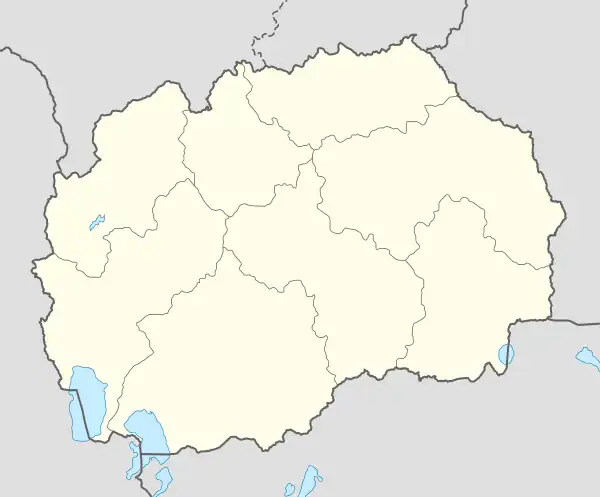Kodžadžik
Kodžadžik (Macedonian: Коџаџик; Turkish: Kocacık), is a village in the municipality of Centar Župa, North Macedonia. The village is inhabited mainly by Turks.
Kodžadžik
Коџаџик Kocacık | |
|---|---|
Village | |
 Airview of the village | |
 Kodžadžik Location within North Macedonia | |
| Coordinates: 41°27′N 20°36′E | |
| Country | |
| Region | |
| Municipality | |
| Population (2021) | |
| • Total | 146 |
| Time zone | UTC+1 (CET) |
| • Summer (DST) | UTC+2 (CEST) |
| Car plates | DB |
| Website | . |
Name
A former Ottoman fortress existed at the location of Kodžadžik before the end of the first half of the 15th century.[1] Scholars such as Smiljanić and Hadži Vasiljević stated that a battle between Skanderbeg and the Ottoman Turks took place in the area, and that the name of the village derives from the Ottoman Turkish expression kocacenk, which means big battle.[1]
History
According to historians, the village was first mentioned in 1385 and the name of the village means Great Battle.[2] It was known as Sfetigrad before the Ottoman conquest in 1448, in which Ottoman forces captured it from forces of the League of Lezhë after sieging it for three months.[3]
After the Ottoman conquest, according to Turkish historiography, Kodžadžik was settled by Ottoman soldiers and Turkish nomads (Yörüks). The local church was converted to an Ottoman mosque, and Kodžadžik, as part of the sanjak (district) Debra-i Bala, became a center that connected the southeast with Albania and the Adriatic Sea. The fortress of Kodžadžik is recorded in the Ottoman defter of 1467 with 51 household heads being attested who were exempt from paying the haraç tax as long as they maintained the upper fortress. The personal names recorded are of a mixed local Albanian-Slavic (and more generally Christian) character, although the Slavic onomastic element predominates. No Turkic settlers were recorded.[4]
The carpenters of the upper castle, who were also exempt from taxes, were: Gjin Drodgjeri; Bogiçe, son of Gjin; and Aleko, son of Gjin.[5]
During the Ottoman era, the local population converted to Islam and adopted a Turkish identity.[6] Kodžadžik is known for the house of Mustafa Kemal Atatürk's parents. The memorial house of Kemal Atatürk's father was reconstructed in Kodžadžik.[7]
On his ethnic map of Northwestern Macedonia in 1929, Afanasy Selishchev marked Kodžadžik as a mixed Bulgarian-Turkish village.[8]
Demographics
The village is inhabited by a Turkish speaking population consisting of Turks.[9][10]
According to the 2002 census, the village had a total of 275 inhabitants, who all are Turks.[11] As of the 2021 census, Kodžadžik had 146 residents with the following ethnic composition:[12]
- Turks 141
- Persons for whom data are taken from administrative sources 5
References
- Włodzimierz, Pianka (1970). Toponomastikata na Ohridsko-Prespanskiot bazen. Institut za makedonski jazik "Krste Misirkov". p. 43. "Коџаџик е село и најбогата историја во овој крај. Тука била некогашна Турска тврдина која постоела пред крајот на I пол. од XV в. (Радониќ, Скендербег, 243). Кај Смиљаниќ (с.66) и Хаџи Васиљевиќ (Г. Дебар, 141) е запишано предание за битка меѓу Скендербег и Турците, со која е поврзана народната етимологија на селото (од "kocacenk" -Коџаџик, на Турски: голема битка)."
- Makfax
- Some sources refer to the siege occurring in 1449. Most original documents, however, only refer to it happening in 1448. See: Schmitt p. 93.
- Caka, Eduart (2019). Defteri i hollësishëm për zonat e dibrës i vitit 1467. Tiranë: Akademia e studimeve albanologjike instituti historisë. p. 59.
Radeko Porteviri; Pejo (possibly, Pijo), son of Radeko; Todor Koleci; Bogçeja son of Todor; Nikolla son of Drago; Todor Drago; Jançe, brother of Todor; Radako, brother of Jançe; Dimitri Pavli; Ivan Koleci; Nikolla son of Tanas; Gjorgje Pavli; Dimitri Koleci; Pavël Kallogjeri; Gjoni, son of Pavël; Pop Bojko; Nikolla brother of Pop Bojko; Gjon Strumahu; Petër Kalani; Radec Deskoviçi; Petko Shirgji; Todori, brother of Petko; Radçe Bogisha; Dimitri Zaharia; Ifço Bogiçi; Bogiçe, son of Ifço; Gjon Llazari; Vlashi, brother of Gjon; Nikolla Bratani; Gjorgo Strumahu; Gjergj Koleci; Nanko, brother of Gjergj; Pjeko Obertko (Obretko); Nenko, brother of Pjeko; Todori, brother of Nenko; Gjuro Kozhonari; Ninec Damziqi; Brato, brother of Ninec; Pjero Llazini; Pop Ratko; Radqe Stanisha; Zaharia Stanisha; Ninec Vidiqi; Radçe Kozhari; Dabërto Strumahu; Dako Masktori; Bushko Todori; and Ninec Dajçi
- Caka, Eduart (2019). Defteri i hollësishëm për zonat e dibrës i vitit 1467. Tiranë: Akademia e studimeve albanologjike instituti historisë. p. 59.
- Anna Zadrożna. "Reconstructing the past in a post-Ottoman village:Turkishness in a transnational context" (Document). p. 3.
{{cite document}}: Cite document requires|publisher=(help) - MIA
- Афанасий Селищев. „Полог и его болгарское население. Исторические, этнографические и диалектологические очерки северо-западной Македонии“. – София, 1929, стр. 26.
- Vidoeski, Božidar (1998). Dijalektite na makedonskiot jazik. Vol. 1. Makedonska akademija na naukite i umetnostite. ISBN 9789989649509. p.214. "Турски етнички елемент живее во Жупа - во селата: Коџаџик, Новаци, Брештани, Елевци, Евла, Долгаш, Ослоница и Праленик, и нешто во градот Дебар." p. 326.
- Bunguri, Adem (2009). "Kalaja e Koxhaxhikut (Dibër) [Koxhaxhik's Castle (Dibër)]". Studime Historike (1–02): 44. "Është kjo arsyeja që pranë kalasë së Koxhaxhikut sot gjenden 6 fshatra turqishtfolës, që janë: Pralanik, Breshtan, Novak, Elefc, Koxhaxhik dhe Dollgash."
- Macedonian Census (2002), Book 5 - Total population according to the Ethnic Affiliation, Mother Tongue and Religion, The State Statistical Office, Skopje, 2002, p. 189.
- Total resident population of the Republic of North Macedonia by ethnic affiliation, by settlement, Census 2021